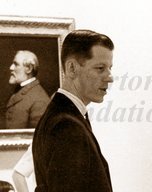
|

|
|
|
|
Jerry was born in Boulder City, Nevada to John and Helen Wilson Bloomer, a teacher of the deaf. Although the family lived briefly in Romney, West Virginia, where his mother taught school for the deaf, Jerry spent much of his younger life in Tucson. There the family owned a chicken ranch "out in the boonies." Jerry performed chores around the business, such as feeding the chickens, and rode his own horse. An airborne disease, he believes, killed the chickens in a short period of time. "We no longer had a chicken ranch after that," he remarks. Jerry's parents were divorced when he was still a young child. His mother did not re-marry. In the late 1940s mother and son moved to Little Rock where she taught at the Arkansas School for the Deaf. They lived on campus. She also taught piano. Jerry graduated from Little Rock Central High School in May of 1950, "the year before Eisenhower sent the troops in," he recounts of the incident over integration. In August of 1950 they moved to Shreveport, where Mrs. Bloomer taught in a private school, working with partially deaf students. Jerry attended Centenary College, majoring in business administration for about a year and a half, until he was drafted into the U.S. Army in 1952. He completed basic training at Fort Bliss in El Paso, Texas, and then was sent to Fort Riley, Kansas. The army, he recalls, taught him to drive. "I never drove a car or anything before," he remarks. After completing truck driver school he was sent to Fort Bragg in Fayetteville, North Carolina, where he was placed as a clerk in a headquarters unit. Soon after learning his mother had cancer, he was given a hardship discharge as the only surviving family member, and returned to Shreveport. "She did recover," he recalls. Jerry re-entered Centenary College and worked as a shoe salesman in a downtown store. He next worked for Burroughs Corporation as a clerk, then as a clerk in the law office of John Paul Woodley. Jerry married Shirley Walker on August 30, 1956. (They would have one son.) On November 1, 1963 Jerry left the law firm and went to work at R.W. Norton Art Gallery as a secretary-bookkeeper for Richard W. (Dick) Norton, Jr., and his wife, Margaret. The museum had not yet opened to the public. (In 1946 the family had created R.W. Norton Art Foundation, which comprised the family's art collection.) The building housing the museum, he says, was begun "sometime in '59" and finished in 1962. Frank Todaro served as building and grounds superintendent. The size of the staff, in the early years of the museum, "was probably less than ten," Jerry says. He and the Nortons worked long hours, often on Saturdays and at nights, "basically doing cataloging," he remarks. "It was not an easy task. It took a lot of work and a lot of time," he recalls. Jerry also helped install the art. "I think I touched every painting," he says. The museum opened to the public on November 16, 1966. Between 1 and 6 p.m., 1,600 persons toured the facility. First year's attendance, Jerry recalls, was "20,800 plus." Displays for other works in the permanent collection continued to be built, such as pedestals for sculptures, by Neff Construction of Shreveport, and cabinets for Wedgwood, silver, and glass collections, built by Michael Art Bronze, a Kentucky firm. Meanwhile Mrs. Norton began creating the museum's famous azalea displays. "When I came here there was one azalea bed behind the east part of the building," he remembers. He fondly remembers the couple. Mr. Norton, Jerry recalls, was "methodical. He was somewhat quiet, yes. He did not like to be out in the public much. He was sort of a homebody, you might say. But he had a keen interest in art obviously." When Norton passed away in 1974, Margaret became president of the board. Jerry continued coordinating the museum's business in correspondence, bookkeeping, and other areas, including public relations. The museum, Jerry remarks, has grown to become the "second largest museum in the state outside of New Orleans. We're also the largest between here and Dallas and from here and Little Rock, and here and Houston." The Norton, he also notes, has never charged admission. Over the years it has featured exhibits from its own permanent collections, and one-artist shows, such as those of Albino Hinojosa, Alexander Dzigurski, Norman Rockwell and Ansel Adams. The museum has also showcased displays from Smithsonian Institution Traveling Exhibition Service (SITES). The largest special exhibit, Jerry recalls, was a Hudson River School exhibition, in addition to the museum's collection of that school of works. "It was a tremendous show," he recalls, because "people down here had not seen paintings like that." Often, in a year, the Norton hosted "maybe six or seven exhibits." In his leisure time, Jerry performed in local theater, an interest that dates to his college days. Much of his later stage work was with Shreveport Little Theater, including lead role in Tea House of the August Moon. He also began growing roses (as well as orchids) and exhibited in a Holiday in Dixie flower show in 1967 when he won best-in-show and other blue ribbons. Jerry has seen north and south wings added to the building--part of the Nortons' long-term plan that allows more of the permanent collection to be displayed. On the average, he remarks, the size of the staff has grown to approximately twenty-five working fulltime. As of 2011, Jerry was continuing his wide-ranging duties at the museum. |


